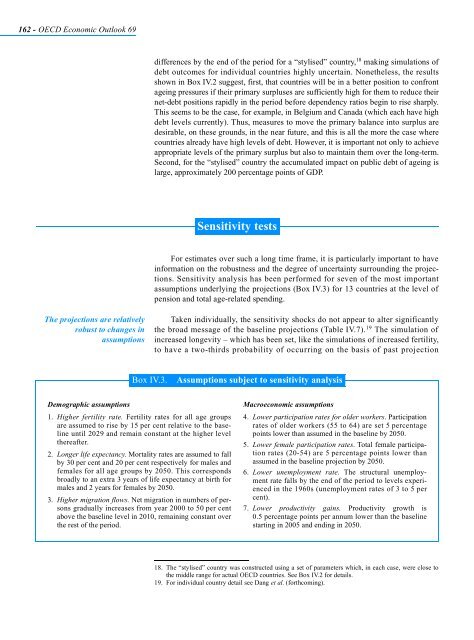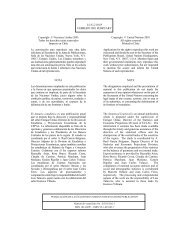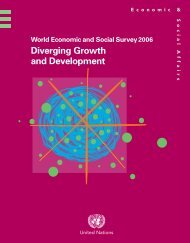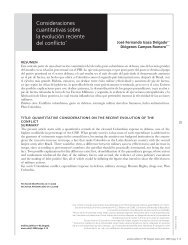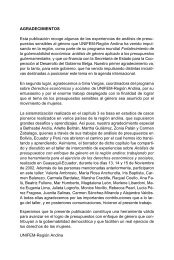OECD Economic Outlook 69 - Biblioteca Hegoa
OECD Economic Outlook 69 - Biblioteca Hegoa
OECD Economic Outlook 69 - Biblioteca Hegoa
Create successful ePaper yourself
Turn your PDF publications into a flip-book with our unique Google optimized e-Paper software.
162 - <strong>OECD</strong> <strong>Economic</strong> <strong>Outlook</strong> <strong>69</strong><br />
The projections are relatively<br />
robust to changes in<br />
assumptions<br />
Demographic assumptions<br />
1. Higher fertility rate. Fertility rates for all age groups<br />
are assumed to rise by 15 per cent relative to the baseline<br />
until 2029 and remain constant at the higher level<br />
thereafter.<br />
2. Longer life expectancy. Mortality rates are assumed to fall<br />
by 30 per cent and 20 per cent respectively for males and<br />
females for all age groups by 2050. This corresponds<br />
broadly to an extra 3 years of life expectancy at birth for<br />
males and 2 years for females by 2050.<br />
3. Higher migration flows. Net migration in numbers of persons<br />
gradually increases from year 2000 to 50 per cent<br />
above the baseline level in 2010, remaining constant over<br />
the rest of the period.<br />
differences by the end of the period for a “stylised” country, 18 making simulations of<br />
debt outcomes for individual countries highly uncertain. Nonetheless, the results<br />
shown in Box IV.2 suggest, first, that countries will be in a better position to confront<br />
ageing pressures if their primary surpluses are sufficiently high for them to reduce their<br />
net-debt positions rapidly in the period before dependency ratios begin to rise sharply.<br />
This seems to be the case, for example, in Belgium and Canada (which each have high<br />
debt levels currently). Thus, measures to move the primary balance into surplus are<br />
desirable, on these grounds, in the near future, and this is all the more the case where<br />
countries already have high levels of debt. However, it is important not only to achieve<br />
appropriate levels of the primary surplus but also to maintain them over the long-term.<br />
Second, for the “stylised” country the accumulated impact on public debt of ageing is<br />
large, approximately 200 percentage points of GDP.<br />
Sensitivity tests<br />
For estimates over such a long time frame, it is particularly important to have<br />
information on the robustness and the degree of uncertainty surrounding the projections.<br />
Sensitivity analysis has been performed for seven of the most important<br />
assumptions underlying the projections (Box IV.3) for 13 countries at the level of<br />
pension and total age-related spending.<br />
Taken individually, the sensitivity shocks do not appear to alter significantly<br />
the broad message of the baseline projections (Table IV.7). 19 The simulation of<br />
increased longevity – which has been set, like the simulations of increased fertility,<br />
to have a two-thirds probability of occurring on the basis of past projection<br />
Box IV.3. Assumptions subject to sensitivity analysis<br />
Macroeconomic assumptions<br />
4. Lower participation rates for older workers. Participation<br />
rates of older workers (55 to 64) are set 5 percentage<br />
points lower than assumed in the baseline by 2050.<br />
5. Lower female participation rates. Total female participation<br />
rates (20-54) are 5 percentage points lower than<br />
assumed in the baseline projection by 2050.<br />
6. Lower unemployment rate. The structural unemployment<br />
rate falls by the end of the period to levels experienced<br />
in the 1960s (unemployment rates of 3 to 5 per<br />
cent).<br />
7. Lower productivity gains. Productivity growth is<br />
0.5 percentage points per annum lower than the baseline<br />
starting in 2005 and ending in 2050.<br />
18. The “stylised” country was constructed using a set of parameters which, in each case, were close to<br />
the middle range for actual <strong>OECD</strong> countries. See Box IV.2 for details.<br />
19. For individual country detail see Dang et al. (forthcoming).


